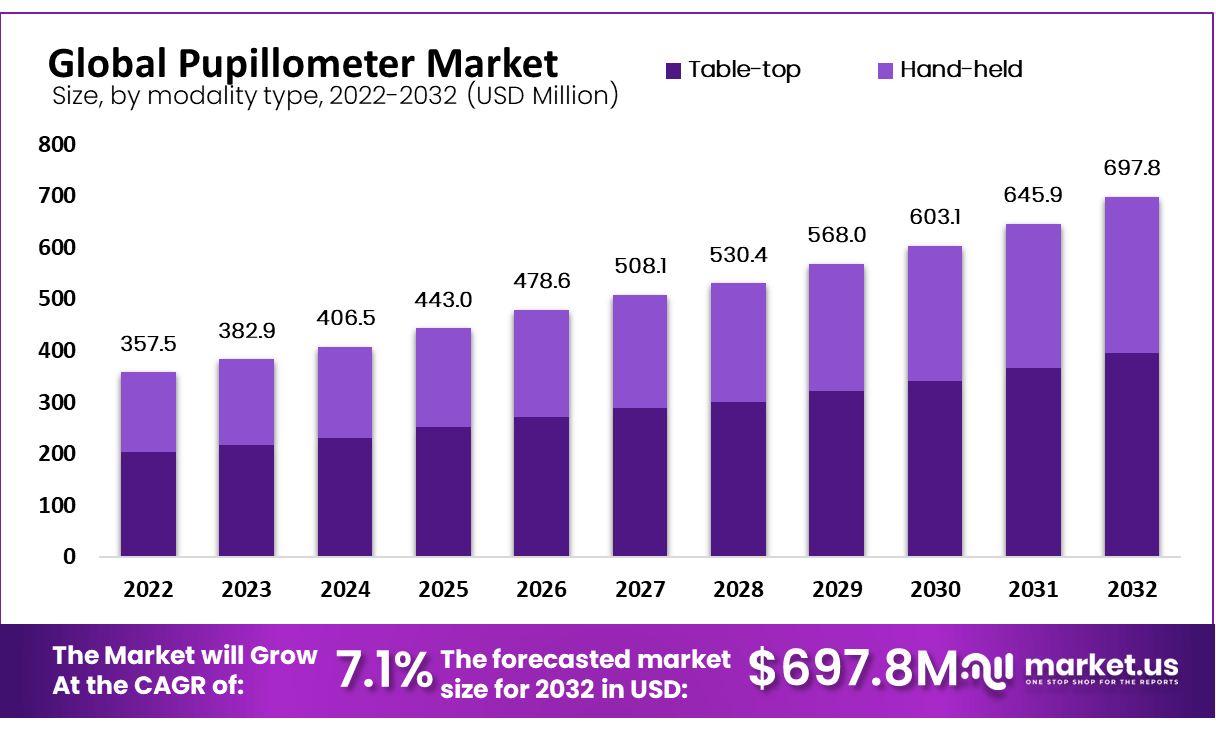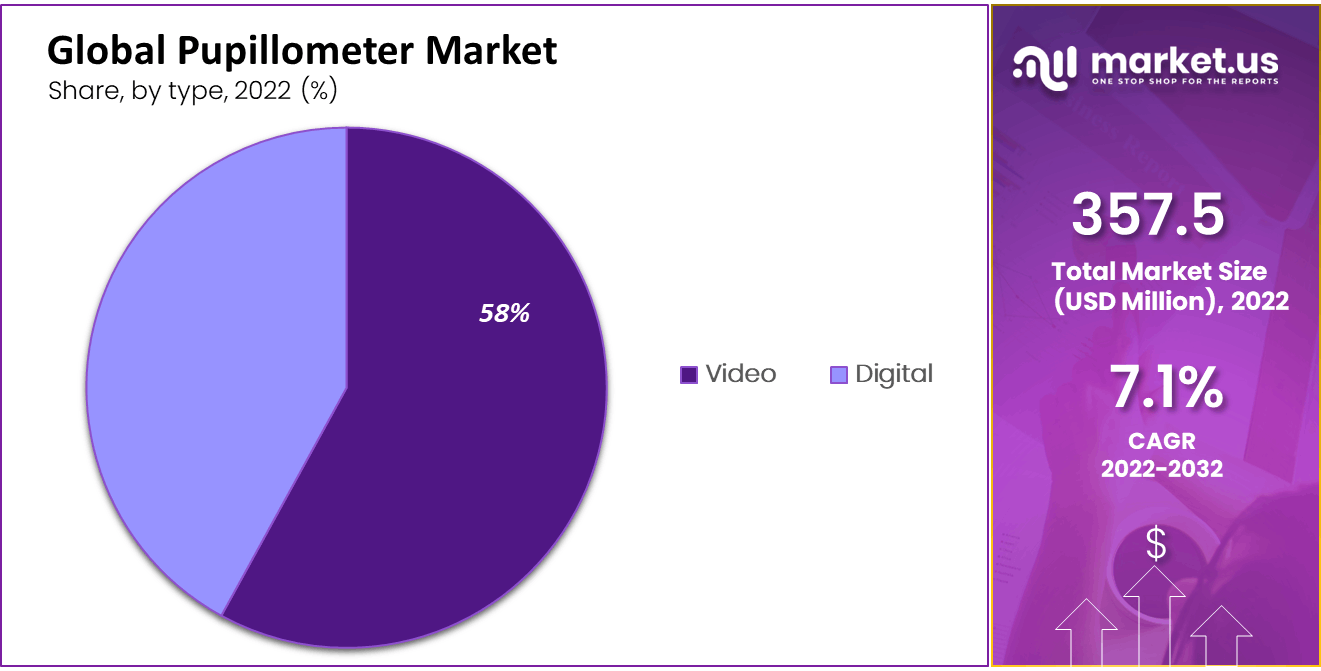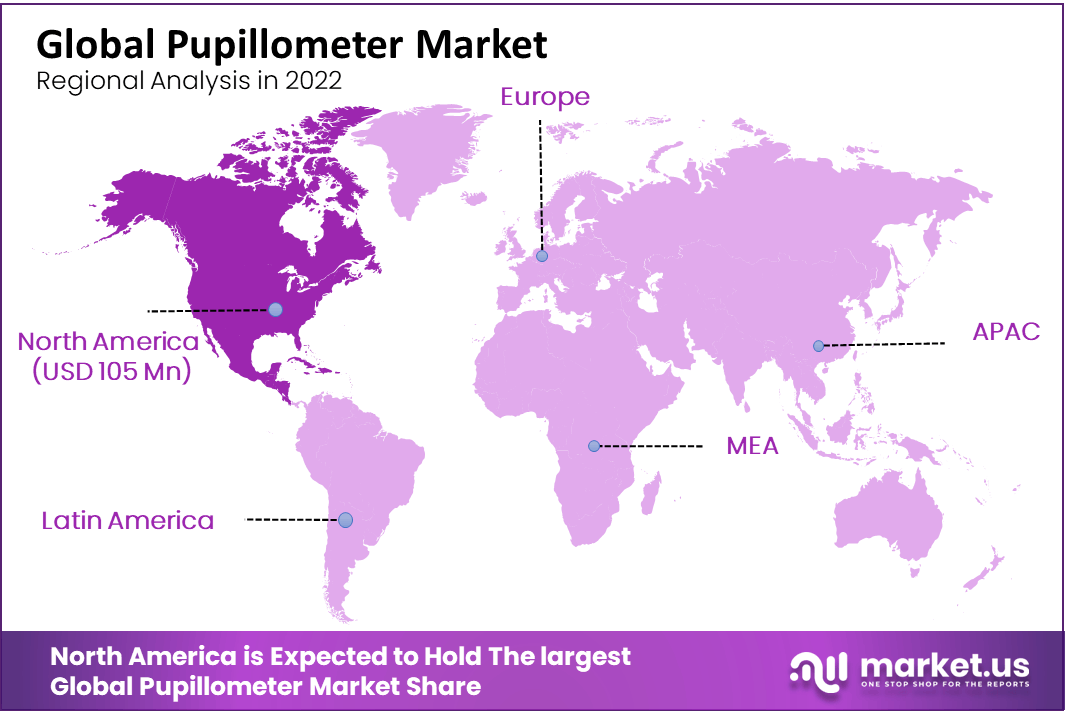Global Pupillometer Market By Modality Type (Table-top and Hand-held), By Type (Video and Digital), By Application (Ophthalmology, Neurology, Oncology, and Other Applications), By End-User, By Region and Companies - Industry Segment Outlook, Market Assessment, Competition Scenario, Trends, and Forecast 2023-2032
- Published date: Oct 2023
- Report ID: 100383
- Number of Pages: 369
- Format:
- keyboard_arrow_up
Quick Navigation
Report Overview
The Global Pupillometer Market size is expected to be worth around USD 697.8 Million by 2032 from USD 357.5 Million in 2022, growing at a CAGR of 7.10% during the forecast period from 2023 to 2032.
The pupillometer is a medical device that is used to measure the size & reaction of the pupils. Pupillometers are generally used in ophthalmology, neurology, and emergency medicine to assess the function of the pupil and detect any abnormalities. The market for pupillometers is expected to grow steadily in the forthcoming years, driven by factors such as an increasing prevalence of neurological disorders, rising healthcare expenditure, and growing demand for non-invasive diagnostic tools.
In addition, technological advancements, and the development of portable and handheld pupillometers are expected to further drive market growth.

*Actual Numbers Might Vary In The Final Report
Key Takeaways
- Pupill Assessment: Pupillometers are widely used to accurately and objectively assess pupil sizes, shapes, and reactivity – providing invaluable diagnostic insights about neurological and ophthalmological health of an individual patient.
- Neurological Applications: Pupillometers have many uses within neurology; specifically monitoring changes to pupil size and reactivity to detect neurological conditions like brain injuries, brainstem dysfunction or changes in intracranial pressure.
- Ophthalmological Uses: Pupillometers can assist eyecare practitioners by measuring pupillary function and diagnosing eye conditions like glaucoma or drug effects on eyelashes, among others.
- Critical and Emergency Care Medicine: Pupillometers play an essential role in both critical care and emergency medicine by helping monitor patients in intensive care units as well as assess neurological status following trauma or surgery.
- Quantitative Pupil Assessment: Pupillometers provide quantitative measurements of pupil size and reactivity, eliminating subjectivity during evaluation while improving exam accuracy.
- Rapid and Non-Invasive: Pupillometry is an extremely fast and non-invasive testing procedure suitable for use across a wide variety of clinical environments.
Driving Factors
Increasing prevalence of neurological disorders and rising healthcare expenditure in the market.
Neurological disorders like traumatic brain injury, stroke, and epilepsy often affect the function of the pupils. Pupillometers are used to assess the function of the pupils as well as detect any abnormalities. As the prevalence of neurological disorders increases, the demand for pupillometers is also expected to rise.
Healthcare expenditure has been increasing globally, driven by factors such as an aging population and the growing burden of chronic diseases. As healthcare expenditure increases, there is a super focus on investing in diagnostic tools that can help improve patient outcomes, including pupillometers.
Restraining Factors
High cost of pupillometers and lack of awareness, access & reimbursement policies about Pupillometers.
Pupillometers can be relatively expensive, particularly those with advanced features or that are designed for use in specialized settings. This can limit their adoption, particularly in regions or healthcare systems with limited budgets. While pupillometers are widely used in ophthalmology and neurology, there may be limited awareness of their benefits among some healthcare professionals or patients.
In addition, access to pupillometers may be limited in some regions or healthcare systems. In some regions or healthcare systems, there may be a lack of reimbursement policies for pupillometers. This can limit their adoption, particularly in settings where healthcare providers may not be able to bear the cost of the device. These factors can hinder the growth of pupillometers.
Growth Opportunities
Development of advanced pupillometers and increasing use in sports medicine, another opportunity is increasing adoption in emerging markets.
Advances in technology, such as the use of artificial intelligence & machine learning, are expected to lead to the development of more advanced pupillometers. These devices could offer greater accuracy, improved portability, and enhanced diagnostic capabilities, which could drive adoption among healthcare providers. Pupillometers are also used in sports medicine to assess concussion and traumatic brain injuries. With growing awareness of the potential risks of sports-related head injuries, the use of pupillometers in sports medicine is expected to rise, presenting an opportunity for pupillometer producers.
Emerging markets like Asia-Pacific and Latin America, are expected to experience significant growth in healthcare expenditure & infrastructure development in the upcoming years. This presents an opportunity for pupillometer manufacturers to expand their reach into these regions and tap into the growing demand for non-invasive diagnostic tools.
Trending Factors
Technological advancements and use in emergency medicines.
Technological advancements are driving the development of more advanced & portable pupillometers. For example, some pupillometers now feature wireless connectivity, enabling real-time data transfer and analysis. Other advancements include the use of artificial intelligence and machine learning algorithms, which can improve the accuracy & speed of diagnosis.
Pupillometers are increasingly being used in emergency medicine to assess patients with head injuries, stroke, and other neurological conditions. This trend is driven by the require diagnosing these conditions rapidly and accurately in emergency settings.
Rising demand for non-invasive diagnostic tools and pupillometers in ophthalmology and neurology.
As patients become more aware of the risks associated with invasive diagnostic procedures, there is a rising demand for non-invasive diagnostic tools like pupillometers. This trend is expected to continue driving demand for pupillometers in the coming years. Pupillometers are widely used in ophthalmology and neurology to assess the function of the pupils and detect any abnormalities. As the prevalence of neurological disorders & eye diseases increases, the demand for pupillometers is also expected to increase.
Modality Analysis
The table-top fragment is the most lucrative in the modality type of pupillometer market.
Based on modality, the market for pupillometer market is divided into table-top and hand-held. Among these types, the tabletop segment is the most lucrative in the global pupillometer market. The total revenue share of the table-top type is 56.6% in 2022 for the pupillometer market. Owing to tabletop pupillometers are larger and typically used in clinical settings like hospitals & ophthalmology clinics, where they can be used to conduct many comprehensive diagnostic tests on patients.
These pupillometers are generally more expensive and offer advanced features & capabilities. Hand-held pupillometers are smaller, more portable, and often used in emergency and field settings like by paramedics and military personnel. They are designed for ease of use and quick measurements of pupillary size and reactivity.
Type Analysis
The video segment accounted for the largest revenue share in the pupillometer market.
Based on type, the market is segmented into video & digital. Among these, the video segment is estimated to be the most lucrative segment in the global pupillometer market, with the largest revenue share of 58% for the forecast period. Video pupillometers use cameras to record the pupillary response and then analyze the video footage to measure the size as well as the reactivity of the pupils.
These pupillometers are generally less expensive than digital pupillometers and can provide quick measurements in field & emergency settings. Digital pupillometers use digital sensors to measure the size and reactivity of the pupils. Digital pupillometers are more accurate than video pupillometers.
Application Analysis
The ophthalmology fragment is the most lucrative in the application type of pupillometer market.
Based on application, the market for pupillometer market is divided into ophthalmology, neurology, oncology, and other applications. Among these applications, the ophthalmology segment is the most profitable in the global pupillometer market. The total revenue share of the ophthalmology type is 51% in 2022 for the pupillometer market.
Ophthalmology is a major application area for pupillometers, they are commonly used to diagnose and monitor eye conditions such as glaucoma & cataracts. Pupillometers can also be used in neurology to assess brain function and diagnose neurological conditions such as concussions as well traumatic brain injuries.
End-User Analysis
Hospitals hold a significant share of the end-user segment in the pupillometer market.
Based on end-user, the market is divided into hospitals, eye clinics, and other end-users. Hospitals are dominant in the end-user fragment in the pupillometer market, with a market share of 51%. Hospitals are a major end-user of pupillometers, as they are generally used in emergency and critical care settings to assess the neurological status of patients. Eye clinics are also a significant end-user of pupillometers, as they are often used to diagnose and monitor eye conditions like glaucoma & cataracts.

Key Market Segments
Based on Modality Type
- Table-top
- Hand-held
Based on Type
- Video
- Digital
Based on Application
- Ophthalmology
- Neurology
- Oncology
- Other Applications
Based on End-User
- Hospitals
- Eye Clinics
- Other End-Users
Regional Analysis
North America accounted for the largest revenue share in the pupillometer market in 2022.
North America is estimated to be the most lucrative market in the global pupillometer market, with the largest market share of 29.3%, in 2022, and is expected to register a CAGR of 7.1% during the forecast period. Owing to driven by the high prevalence of neurological disorders, increasing healthcare expenditure, and growing demand for non-invasive diagnostic tools.
The United States is the major contributor to the North American pupillometer market owing to the presence of a large number of manufacturers and a highly developed healthcare system. APAC is expected as the fastest growing region in the projected period in the pupillometer market.

Key Regions
- North America
- The US
- Canada
- Mexico
- Western Europe
- Germany
- France
- The UK
- Spain
- Italy
- Portugal
- Ireland
- Austria
- Switzerland
- Benelux
- Nordic
- Rest of Western Europe
- Eastern Europe
- Russia
- Poland
- The Czech Republic
- Greece
- Rest of Eastern Europe
- APAC
- China
- Japan
- South Korea
- India
- Australia & New Zealand
- Indonesia
- Malaysia
- Philippines
- Singapore
- Thailand
- Vietnam
- Rest of APAC
- Latin America
- Brazil
- Colombia
- Chile
- Argentina
- Costa Rica
- Rest of Latin America
- Middle East & Africa
- Algeria
- Egypt
- Israel
- Kuwait
- Nigeria
- Saudi Arabia
- South Africa
- Turkey
- United Arab Emirates
- Rest of MEA
Key Players Analysis
The global pupillometer market is highly competitive and fragmented, with the presence of few key players. Some of the major players operating in the market include NeurOptics Inc., US Ophthalmic, Luneau Technology Group, Konan Medical USA Inc., and others. For example, NeurOptics Inc. is a leader in the pupillometer market, offering advanced pupillometer products for use in critical care, emergency medicine, and neurology. The company has a strong presence in North America and is known for its innovative products & technologies.
Market Key Players
Listed below are some of the most prominent pupillometer industry players.
- NeurOptics Inc.
- Adaptica
- Essilor Instruments USA
- HAAG-STREIT GROUP
- Johnson & Johnson Vision
- Luneau Technology Group
- NIDEK CO. LTD.
- Reichert Technologies
- SCHWIND eye-tech-solutions
- US Ophthalmic
- Konan Medical
- Brightlamp Inc.
- Other Key Players
Recent Developments
- In July 2021, NeurOptics Inc. received FDA clearance for its latest Neurological Pupillometer, a device that measures the neurological status of critically ill patients by analyzing the pupillary light reflex.
- In September 2021, Luneau Technology Group acquired Visionix, a leading provider of advanced eye diagnostic solutions, to expand its product portfolio & strengthen its global presence.
Report Scope
Report Features Description Market Value (2022) USD 357.5 Million Forecast Revenue (2032) USD 126.1 Million CAGR (2023-2032) 7.1% Base Year for Estimation 2022 Historic Period 2016-2021 Forecast Period 2023-2032 Report Coverage Revenue Forecast, Market Dynamics, COVID-19 Impact, Competitive Landscape, Recent Developments Segments Covered By Modality Type-Table-top, and Hand-held; By Type-Video and Digital; By Application-Ophthalmology, Neurology, Oncology, and Other Applications; By End-User- Hospitals, Eye Clinics, and Other End-Users Regional Analysis North America – The US, Canada, & Mexico; Western Europe – Germany, France, The UK, Spain, Italy, Portugal, Ireland, Austria, Switzerland, Benelux, Nordic, & Rest of Western Europe; Eastern Europe – Russia, Poland, The Czech Republic, Greece, & Rest of Eastern Europe; APAC – China, Japan, South Korea, India, Australia & New Zealand, Indonesia, Malaysia, Philippines, Singapore, Thailand, Vietnam, & Rest of APAC; Latin America – Brazil, Colombia, Chile, Argentina, Costa Rica, & Rest of Latin America; the Middle East & Africa – Algeria, Egypt, Israel, Kuwait, Nigeria, Saudi Arabia, South Africa, Turkey, United Arab Emirates, & Rest of MEA Competitive Landscape NeurOptics Inc., Adaptica, Essilor Instruments USA, HAAG-STREIT GROUP, Johnson & Johnson Vision, Luneau Technology Group, NIDEK CO. LTD., Reichert Technologies, SCHWIND eye-tech-solutions, US Ophthalmic, Konan Medical, Brightlamp Inc., Other Key Players Customization Scope Customization for segments, region/country-level will be provided. Moreover, additional customization can be done based on the requirements. Purchase Options We have three licenses to opt for Single User License, Multi-User License (Up to 5 Users), Corporate Use License (Unlimited User and Printable PDF) 
- NeurOptics Inc.
- Adaptica
- Essilor Instruments USA
- HAAG-STREIT GROUP
- Johnson & Johnson Vision
- Luneau Technology Group
- NIDEK CO. LTD.
- Reichert Technologies
- SCHWIND eye-tech-solutions
- US Ophthalmic
- Konan Medical
- Brightlamp Inc.
- Other Key Players
- settingsSettings
Our Clients
| Single User $4,599 $3,499 USD / per unit save 24% | Multi User $5,999 $4,299 USD / per unit save 28% | Corporate User $7,299 $4,999 USD / per unit save 32% | |
|---|---|---|---|
| e-Access | |||
| Report Library Access | |||
| Data Set (Excel) | |||
| Company Profile Library Access | |||
| Interactive Dashboard | |||
| Free Custumization | No | up to 10 hrs work | up to 30 hrs work |
| Accessibility | 1 User | 2-5 User | Unlimited |
| Analyst Support | up to 20 hrs | up to 40 hrs | up to 50 hrs |
| Benefit | Up to 20% off on next purchase | Up to 25% off on next purchase | Up to 30% off on next purchase |
| Buy Now ($ 3,499) | Buy Now ($ 4,299) | Buy Now ($ 4,999) |












